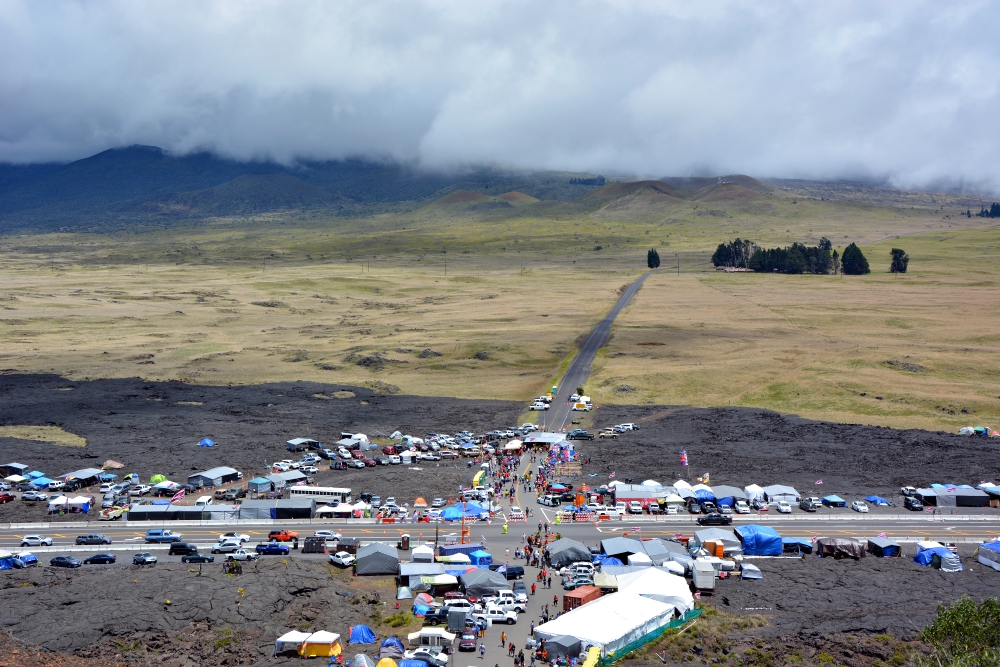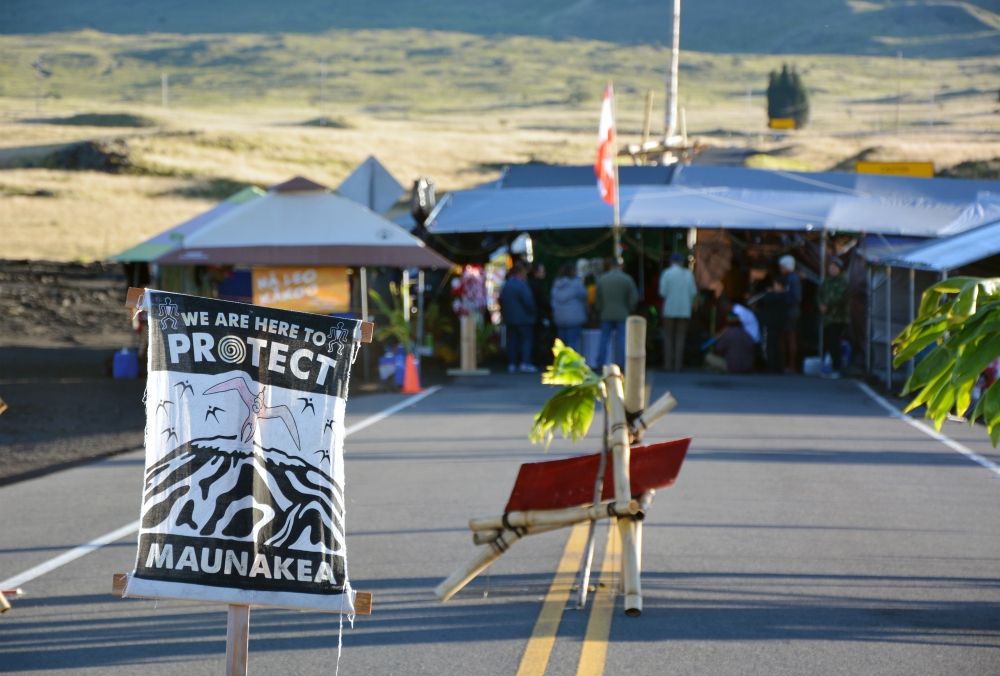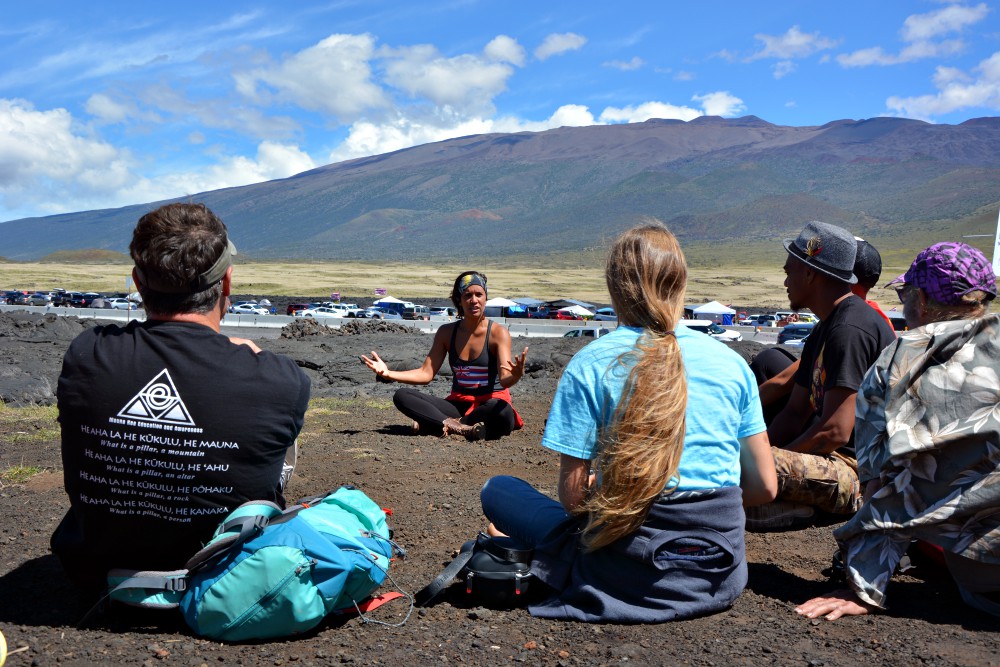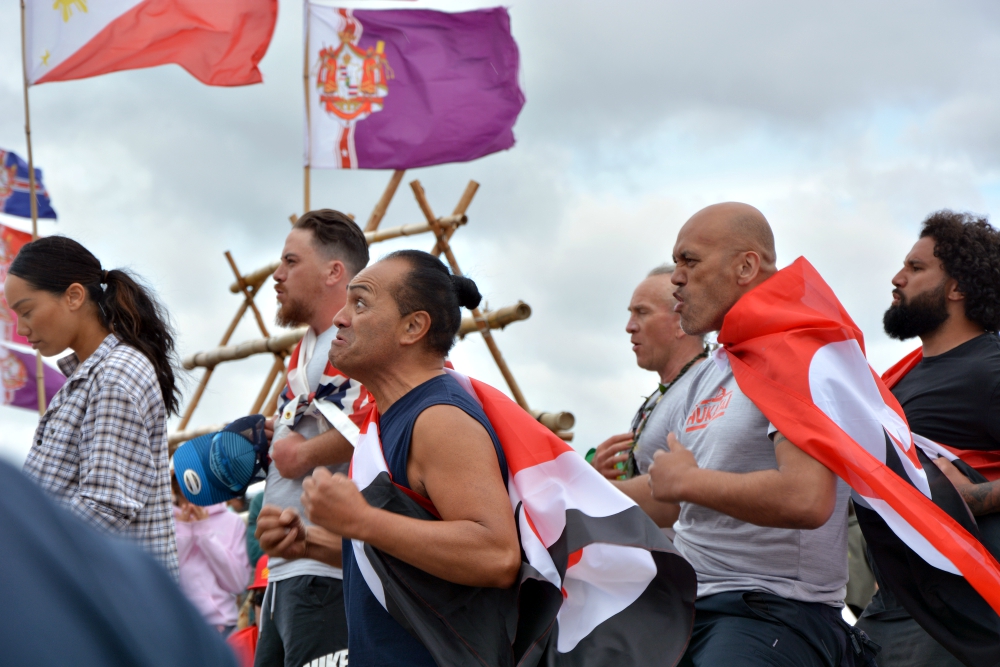
Activists — who prefer the term "protectors" — camp near an access road to Mauna Kea in Hawaii to protest a planned telescope atop the mountain. (RNS/Jack Jenkins)
As the sun began to appear above Hawaii's Mauna Kea Aug. 31, hundreds of temporary residents of the mountain's slopes emerged from cars and tents that dot the nearby blackened lava field, gathering to stand in loose formation.
It was time for the ceremony.
At the direction of a leader speaking in Hawaiian, a chorus of horns fashioned from wood and seashells droned four times, the crowd changing direction after each blow. After one complete rotation, they turned to face Mauna Kea, its towering peaks obscured by a string of wispy rainclouds.
Then, just as they have every day since mid-July, the group began to pray.
"The reason why we do that is to ground ourselves, to remember our sacred purpose for being here, which is to protect the mauna [mountain] from further desecration," said Marie Alohalani Brown, a religious studies professor at the University of Hawaii at Manoa.
Brown is one of thousands of demonstrators — they prefer the term kia'i, or protectors — who have flocked to the camp this summer to block construction of the Thirty Meter Telescope, or TMT, on top of Mauna Kea. Their reasoning is partly environmental: Opponents say the TMT, which would join several existing telescopes atop the mountain, could harm local bird populations and natural aquifers.
Their other reason is unapologetically religious: Native Hawaiians view Mauna Kea as sacred, and that adding yet another telescope amounts to an attack on the divine.
Though the focused outburst of traditional spiritual practice is somewhat unusual for Hawaii, the religious component of the standoff between the demonstrators and government officials is an example of a resurgence of indigenous religion and spirituality animating groups across the United States.
As elsewhere, environmental concerns have summoned native believers who often see little separation between the natural environment and the divine.
"The mountain is a symbol of the most sacred attached to the ... realm of the gods," said Pua Case, one of the leaders of the protectors. "If we don't stand for that, what will we stand for?"

Pua Case, left, speaks to other protectors at the camp blocking the access road to Mauna Kea. (RNS/Jack Jenkins)
Religious practice is a constant at the camp. Organizers host four "protocols" a day — one small ceremony at sunrise, followed by three larger ones throughout the day — during which participants engage in traditional Hawaiian chants, songs and dances.
"The first part of the protocol is all prayers," Brown explained. "The hula [dance] is being performed as an offering, as a prayer — it's not performance, it's not entertainment. Our intentions are praying to the gods to protect the mauna and to protect us."
Though opposition to TMT goes back at least a decade, in 2014 a group of Native Hawaiians interrupted a groundbreaking ceremony for the new telescope, arguing that building more structures on the mountain will only further desecrate a place they deem sacred. Demonstrators blockaded construction crews in March of the following year, setting in motion a lengthy legal dispute. After initially invalidating the TMT's building permits, Hawaii's Supreme Court cleared the telescope for construction in 2019.
But on the first scheduled day of construction, July 17, the protectors once again amassed to block the access road at the base of the mountain, joined by a group of kupuna, or elders, who refused to move when police arrived. Nearly 40 people were arrested, primarily the elderly kupuna.
One of them was Brown, who explained that nonviolent resistance is in keeping with a Native Hawaiian concept known as Kapu Aloha.

Early risers gather at the elder — or "kupuna" — tent positioned along the access road that leads to the top of Mauna Kea in Hawaii. (RNS/Jack Jenkins)
"It's a question of being determined to do whatever — in the spirit of Kapu Aloha — to make sure that the TMT does not happen," she said.
The arrests sparked outrage in Native Hawaiian communities and helped to spur the creation of a sprawling protest camp along the access road. Scattered among the cars and tents are signs and murals emblazoned with slogans such as "We are Hawaii, we are a spiritual nation."
The camp is highly organized, requiring newcomers to sign in to a database using a QR code and boasting its own staffed medical tent. A mix of academics and activists hosts workshops each day on a plot of land across the street that protectors call Pu'uhuluhulu University, which operates under the slogan "an actual place of Native Hawaiian learning."
Among the workshops over Labor Day weekend was one titled "Land-based religion means sacred applies to everyone," given by Mehana Makainai, an instructor at the University of Hawaii at Manoa’s Kamakakuokalani Center for Hawaiian Studies.
"From a creation story standpoint this is connected to our cosmogonic genealogies," Makainai said. "This is where we say, according to some of our stories, that our world — not the entire world, but Hawaii — began. We see the union of Papahanaumoku, earth mother, and Wakea [sky father], right here on this mauna. We have these deep ties through our religious beliefs to Mauna Kea being sacred."

Mehana Makainai teaches a workshop on "land-based religion" in the protest camp at the base of Mauna Kea, Hawaii. (RNS/Jack Jenkins)
Flags left by visitors from around the world flap above the often windy camp, and the day's protocols typically conclude with elders ceremonially welcoming special visitors, including celebrities such as Jason Momoa, star of the superhero film "Aquaman," and Dwayne "The Rock" Johnson.
"The truth is this mountain is their church" Johnson explained to Jimmy Fallon during a July appearance on "The Tonight Show." "It would be like building on their church."
Democratic presidential candidates such as Hawaii's own Rep. Tulsi Gabbard as well as Sen. Elizabeth Warren have also visited or voiced support for the protectors, noting their spiritual concerns and appeal to sacred land.
"Mauna Kea is sacred to Native Hawaiian people," Warren tweeted. "The Hawaiians who have been protesting construction of the Thirty Meter Telescope are trying to protect a sacred site from further desecration. I stand in solidarity with them."
Other groups welcomed at the camp over the weekend included singing children, a group of bikers, a delegation of Maori from New Zealand and representatives from the Democratic Socialists of Honolulu.

A group hailing from different Polynesian islands performs a haka for elders at the base of Mauna Kea. (RNS/Jack Jenkins)
Also among recent visitors were several Native Americans, including LaDonna Brave Bull Allard of the Standing Rock Sioux Tribe, whose backyard was used for prayer camps during the protections against the Dakota Access Pipeline in 2016 and beyond. Asked if she saw a spiritual connection between the camp at Mauna Kea and what she witnessed at Standing Rock, she was unequivocal.
"It is the same," Allard said in a phone interview. "When Standing Rock was happening, the great Hawaiian people came and stood with me. They came in prayer, ceremony and dance to stand with us. We became great allies and friends. So when they stood up again, I went to go stand with them."
She added that what she witnessed at Mauna Kea was "Standing Rock but only better, stronger," praising the centrality of Native Hawaiian religion and culture at the camp.
Case, who also visited the prayer camps in North Dakota at the height of the Standing Rock demonstrations, agreed.
"The tie for all of us is that there is a creator and beyond the creator, there are our elements, the spirit forms," she said. "You look for like-minded and similarly treated people, especially when it has to do with injustice."
Advertisement
The religious feeling here has attracted scholars from the mainland such as Greg Johnson, a professor of religious studies at the University of California at Santa Barbara who specializes in contemporary indigenous traditions. He said he saw multiple streams of Hawaiian religious practice intersecting at the camp, combining to generate negotiated forms of spiritual expression — some new, some much older.
"In terms of religious expression and action, the protest on Mauna Kea is unprecedented in modern times," Greg Johnson, who was among the throngs at the camp over the weekend, told Religion News Service in an email. "This is true in terms of numbers of people involved, the duration of occupation, and certainly in terms of the sheer amount of ceremony gracing the mauna."
While some protectors at Mauna Kea identify solely as practitioners of Native Hawaiian religion, for others the categories are more complicated — albeit not necessarily any less spiritual. Makainai explained that her personal faith draws from Native Hawaiian traditions as well as Christianity, saying, "I find value in both."
Others eschew religion entirely or are drawn to the camp for primarily political reasons. Mikey Inouye, one of the leaders of the Democratic Socialists of Honolulu, has been at the camp for more than a month and sees overlap between his political vision and the goals of the protectors.
Even so, he said the experience has led to unexpectedly close encounters with the spiritual, particularly when participating in religious ritual.

Protectors who oppose the construction of the Thirty Meter Telescope perform traditional Hawaiian dances at the base of Mauna Kea in Hawaii. (RNS/Jack Jenkins)
"Before this experience, I was an atheist," he said. "I'm still an atheist, but there's a very big 'but' with a question mark after that. I don't really know how to describe it — the feeling you get when you're in community with other kia'i on this land, praising and thanking the land, positioning your body so that it is facing that which you are praising. I feel something that I've never felt before."
He added: "That feeling ... I wouldn't describe it as a religious experience, but I wouldn't describe it as a secular experience either."
Protectors at Mauna Kea nevertheless reject framing their dispute with TMT as a conflict between religion and science. It's the proposed location of the telescope, not the machine itself, that troubles them.
"Hawaiian kupuna were the best scientists these islands have ever seen," Makainai said. "They knew how to study the stars — we had to if we were going to be able to sail thousands of miles across the open ocean. They knew how to plant all their foods so they could sustain a population of over a million people without relying on outside resources."
The future of the camp is unclear. Police vehicles remain parked nearby, with some officers clad in camouflage. Organizers at the camp claimed last week to have heard reports that state authorities plan to use National Guard troops to clear the camp in the near future.

Marie Alohalani Brown (Courtesy of University of Hawaii)
A representative from the Hawaii Attorney General's Office responded to questions about the rumored expulsion by telling RNS she could not "confirm or deny on operational issues."
In the meantime, kupuna and others are discussing plans to peacefully resist authorities should they attempt to remove people from the base of the mountain.
"What you would do in your sacred place — your temple, your church — that's what we need up here," Case told the crowd after one protocol.
Brown echoed her call to spiritual discipline.
"It's what I said as I got arrested: 'This is what we do, we protect the sacred,' " she said, her eyes welling up with tears. "I know there's Hawaiians who want the TMT built, and I don't understand that. Because it's not a question of science, it's a question of ... there's certain things you just can't do."
As she spoke, the crowd of protectors behind her began one of the day's protocols. Horns bellowed out a low hum, and the masses turned their bodies to face Mauna Kea. Brown cut the interview short.
"I have to pray," she said.
She then stood, closed her eyes and joined others in reciting a Hawaiian orison.
Tears flowed down her cheeks as she prayed, like water down a mountain.






